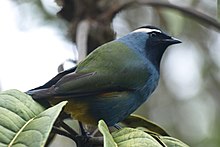Paramythiidae
| Painted berrypeckers | |
|---|---|
 |
|
| Crested berrypecker | |
| Scientific classification | |
| Kingdom: | Animalia |
| Phylum: | Chordata |
| Class: | Aves |
| Order: | Passeriformes |
| Suborder: | Passeri |
| Family: |
Paramythiidae P.L. Sclater, 1893 |
| Genera | |
|
Oreocharis (Salvadori, 1876), |
|
Oreocharis (Salvadori, 1876),
Paramythia (De Vis, 1892)
The painted berrypeckers, Paramythiidae, are a very small bird family restricted to the mountain forests of New Guinea. The family comprises two species in two genera: the tit berrypecker (Oreocharis arfaki) and the crested berrypecker (Paramythia montium). These are colourful medium-sized birds which feed on fruit and some insects. These species were formerly included in the Dicaeidae, but DNA–DNA hybridization studies showed these species were related to each other but distinct from the flowerpeckers. Some sources group painted berrypeckers as two genera belonging to the family Melanocharitidae.
The painted berrypeckers are small to medium sized passerine birds. The smaller species, the tit berrypecker, ranges from 12–14 cm in length and weighs around 17–21 g. The larger crested berrypecker is 19–22 cm in length and weighs 36–61 g. The variation in size in the crested berrypecker is due to differences in altitude (Rapoport's rule), with birds being larger at higher altitudes. Both species have short necks, moderately long and broad rounded wings, and plump bodies. The tails vary between the two species, with the tit berrypecker having a short square one and that of the crested berrypecker being longish. In both species the short bill is strong and black.
The plumage of both species is soft, downy and brightly coloured. In both species the backs and wings are green and the tail is blue-grey. In the tit berrypecker the plumage is sexually dimorphic, with the male having bright yellow patches on the face, wing and chest but the female being overall duller. Both sexes of the crested berrypecker are similar, but the species exhibits instead some variation between two subspecies. The plumages of the juveniles resemble the female in the case of the tit berrypecker and dull adults in the case of the crested berrypecker. The crested berrypecker has, as suggested by the name, an erectile crest. Both species have unique filoplumes (hairlike feathers) on the flanks that are not visible in the field and the function of which is unknown.
...
Wikipedia
